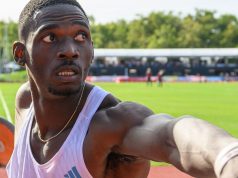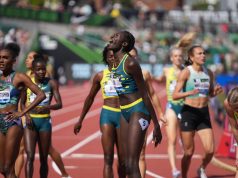Sunday (14 Oct) marked the 50th anniversary of the 1968 Mexico City Games Men’s100 meter final, where American Jim Hines became the first person to pierce the esteemed 10-second barrier in FAT conditions with a 9.95 seconds time to take home gold.
In that race also was Jamaican Lennox Miller, who finished second in 10.04.
It’s a race that often gets overshadowed by other historic firsts in Athletics history. Even by some of the other more heralded feats and stands just from that particular Games that have come to define this memorable Olympiad, i.e. the Tommie Smith and John Carlos black power salute on the Men’s 200-m medal podium.
If the guy who finished second to the first person to run a 9 something can’t often get his merited visibility in history, the runner-up who was sandwiched in between Hines and another American ( in Charlie Greene’s 10.07 ) has almost no chance of being really remembered.
The late Lennox Miller began life in Kingston Jamaica in 1946. He would go on to great prep success earning scholarships to the University of Southern California where he would star and help set the current world record of 38.6 for the defunct 4×110 yard relay, taking and receiving the stick with future professional athletes (among other things) O.J. Simpson.
Father to another world-class sprinter in Inger Miller, who would compete for the United States after her own career at USC, Miller was a modest man often described as not talking much about his track accomplishments.
After the individual events, he and his fellow Jamaican sprinters, including a young Don Quarrie, set a world record in the 4x100m heats of 38.3. Of course, this too would be obscured by the Americans victory in the finals, which lowered the WR to 38.2.
He would go on to win other medals in future international championships, like the 1970 Commonwealth Games where he won a silver in the 100 and anchored Jamaica home to a gold in the 4×100.
In the 1972 Munich Games, he gave a pursuit at Olympic glory one more shot, coming up close again but shorter in Bronze.
His daughter’s success for team USA and gold medals as a part of the 4x100m during the 1996 Olympic games in Atlanta as well as her crowning moment in Seville during the 1999 IAAF World Championships during the Women’s 200m final, has made them the first father-daughter duo to win Olympic medals.
He would spend the majority of his post-career capitalizing off his DDS degree and settling into dentistry practice in Pasadena, California for the remaining 30 years of his life.
Miller’s presence in the race is a factor that should never be lost. The fact that he was a neighbouring second, you could make the argument he helped push Hines to that historic world record. There might not have been that barrier-shattering performance without the man from Kingston who was five-tenths of a second away from also running under 10.
More importantly, his generation was the bridge between the pioneering chapter of Jamaican sprinting that entails the likes of the Arthur Wint, the Hon. Herb McKenley and the quieter Ray Stewarts, Merlene Otteys Michael Greens that inspired the Veronica Campbell-Browns, Asafa Powells the Usain Bolts that ushered in the current renaissance of sprinters remain in and compete for Jamaica.
Not to mention, genetically contributing to the great Diaspora through his daughter Inger, whose spot on those American rosters was reflective of an era where many immigrants from Jamaica, or their children, powered Canada, Great Britain and even the U.S to sprinting gold during the 1980s and 90s.
Although he passed away in 2004, his athletics legacy lives on in the success Jamaica has maintained this past decade. Just think, when he was running Jamaica was still searching for its first Olympic medals in the Men’s and Women’s 100m; now the last three champions in both events have waved the green, yellow and black. As we reflect on Mexico City a half-century later, Lennox Miller was his name.












